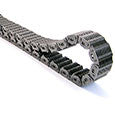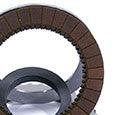- Home
- Knowledge Base
ATC35L/ATC45L Clutch common issues The ATC35L transfer case clutch, like any mechanical component, can encounter various issues over time. Here are some potential problems that may arise:Wear and Tear: Continuous engagement and disengagement of the clutch can lead to wear of the clutch friction materials. Over time, this wear can result in reduced clutch performance and slippage.Contamination: Contamination with products of wear, dirt, or moisture can adversely affect the clutch's operation. Contaminants can cause increased friction, premature wear of clutch assembly components, and, ultimately, clutch mechanism failure.Incorrect Adjustment: Improper adjustment of the clutch mechanism can lead to issues such as...
ATC35L/ATC45L Main shaft common issues While specific information about the ATC35L/ATC45L main shaft's outer splines might be limited (due to the absence of official detailed technical documentation), issues with outer splines on transmission components are not uncommon in general. Here are some potential problems that could occur with the outer splines:Wear and Stripping: The outer splines can wear down over time due to friction and stress from engagement with other components, such as the rear flange (27107593440 is the most susceptible) or clutch (friction plates). This wear can eventually lead to the splines becoming stripped or rounded, resulting in loss...
Cases when replacing the clutch assembly is required Below are cases in which the entire coupling needs to be replaced. This usually happens as a result of overheating, but it can also be a consequence of poor-quality repairs.Figure 1 shows the separation of the splined part (along the groove of the retaining ring) of the drive gear. Such a breakdown is possible on any transfer case - ATC300/ATC400/ATC500/ATC700.Apart from the case mentioned above, you may prefer to install a new one simply because it consists entirely of new parts assembled and adjusted at the factory.
Important information about the ATC35L/ATC45L of the first months of production Suppose you intend to replace the bearings, piston, or levers in the ATC35L or ATC45L transfer cases made in the first months of production. In that case, you should keep the following fact in mind: a few months after the start of production of these transfer cases, the manufacturer changed the design—it switched from using thrust needle cages (No. 24 in the diagram) to needle bearing assemblies with washers.This also entailed changing the thickness of parts 22 (piston), 25 (moving lever), and 27 (fixed lever). That is, the indicated...
DCS/DCD Main shaft issue The most common reason for replacing the transfer case shaft in DCS (as well as DCD) transfer cases is damage to the external splines on the side of the connection with the gearbox. At first, this manifests itself as excess play when starting and stopping, but as this problem progresses, it can result in the car's complete inability to move under its own power. In Figure 1, we showed what damaged main shaft splines look like. Important note: When replacing the transfer case shaft, you should also replace the mating cup on the gearbox side —...
Transfer Cases
-
ATC13 : BMW
-
ATC300 : BMW 3 / 5
-
ATC350 : BMW X1 / 5 / 7
-
ATC35L : BMW 1/2/3/4/5/6/7/X1
-
ATC400 : BMW X3
-
ATC450 : BMW X3 /X5 /X6
-
ATC45L : BMW X3 / X4 / X5 / X6
-
ATC500 : BMW X5
-
ATC700 : BMW X5/X6
-
BW4430 : Audi Q7
-
CB40 (IRD) : Land Rover
-
DCD : Mercedes ML / GL
-
DCS : Mercedes ML / GL / R
-
HAA350+ : VAG
-
HAA450 : VAG
-
Hyundai ATC : Hyundai
-
ITC PLA : Land Rover
-
LX : Chrysler
-
M300+ : VW
-
Macan 95B : Porsche
-
Maserati ATC : Maserati
-
MFA RDM : Mercedes, Infiniti
-
NV125 : BMW X5
-
NV225 : Land Rover
-
NV235 : VAG
-
NV247 : Jeep
-
PL72 ATC : Porsche
-
PL72 T : VAG
-
PQ75+ : VW
-
RDM (312/319) : Fiat
-
SEC : Mercedes S/E/C-class
-
VAA350+ : VAG
-
VG150 : Mercedes
-
VG150 E : Mercedes
-
W61G : Nissan / Infiniti



